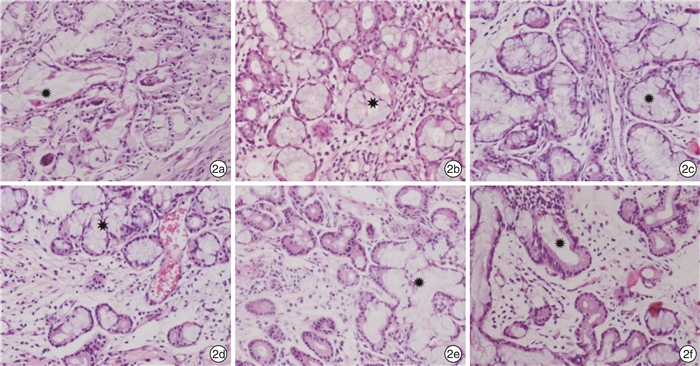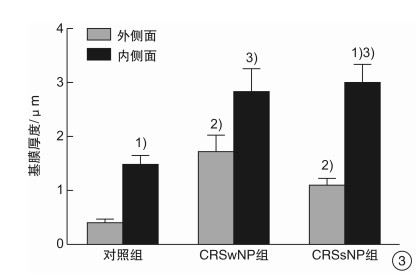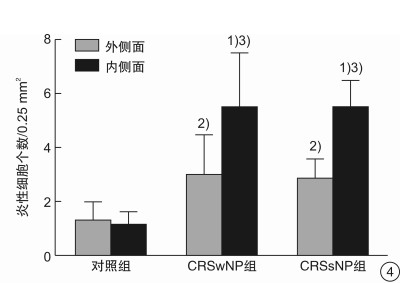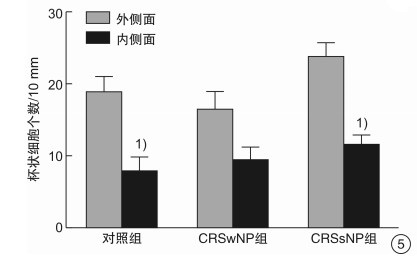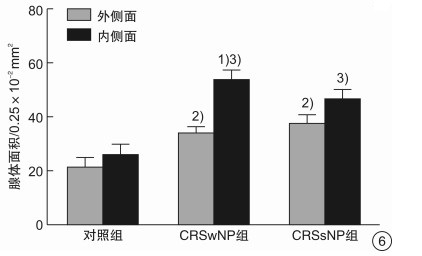The investigation of the histological differences between the mucosa on the nasal and sinus sides of uncinate process of chronic rhinosinusitis
-
摘要: 目的 探讨慢性鼻窦炎患者钩突内外侧面黏膜组织病理学差异及息肉发生的组织病理学基础。方法 收集2016年10月—2017年4月在北京同仁医院耳鼻咽喉头颈外科因慢性鼻窦炎行鼻内镜手术的患者及正常对照者的钩突。同时采集患者病史,分析基膜厚度、固有层腺体的面积、杯状细胞及其他炎性细胞数目等指标。结果 连续入组116例,包括慢性鼻窦炎伴息肉组(CRSwNP组)38例,慢性鼻窦炎不伴息肉组(CRSsNP组)58例,正常对照组20例。3组年龄、性别分布差异无统计学意义(P>0.05)。对照组和CRSsNP组内侧面基膜厚度均明显厚于外侧面(P < 0.05);CRSwNP组和CRSsNP组内外侧面基膜厚度均较对照组相应侧面厚(P < 0.05)。CRSwNP组和CRSsNP组内、外侧面炎性细胞明显较对照组相应侧面多,且内侧面明显比外侧面多(P < 0.05)。3组钩突外侧面杯状细胞数目均比内侧面多,CRSsNP组和对照组比较差异有统计学意义(P < 0.05)。CRSwNP组和CRSsNP组钩突内外侧面腺体面积较对照组相应侧面大,且CRSwNP组内侧面腺体面积明显比外侧面大,差异有统计学意义(P < 0.05)。结论 慢性鼻窦炎患者钩突内外侧面组织病理学存在差异,内侧面比外侧面易发生息肉,可能与基膜增厚、炎性细胞增多、腺体面积增大有关。Abstract: Objective The aim of this study is to check whether histopathological differences exist between the nasal side and the sinus side of uncinate process of chronic rhinosinusitis and the histopathological basis of nasal polyp was discussed.Methods The uncinate processes of chronic rhinosinusitis and control subjects were enrolled from October 2016 to April 2017. The following histopathological data were assessed: height of basement membrane, the proportion of glands in the sub-epithelium, the numbers of goblet cells and inflammatory cells.Results A total of 116 patients were recruited, including 38 chronic rhinosinusitis with nasal polyps(CRSwNP), 58 chronic rhinosinusitis without nasal polyps(CRSsNP) and 20 controls. There was no significant difference between age and gender distribution(P>0.05). The basement membrane was significantly thinner on the sinus side of the 3 groups' uncinate processes than on the nasal side except CRSwNP group(P < 0.05). The basement membrane of CRSwNP and CRSsNP was significantly higher than control uncinate processes(P < 0.05). Inflammatory cells number were significantly increased in CRSwNP and CRSsNP than in the control uncinate processes, and the nasal side was obviously more than the sinus side in the CRSwNP and CRSsNP groups(P < 0.05). The number of goblet cells was more on the sinus side of the 3 groups uncinate processes than on the nasal side, that of CRSsNP and control were significant difference between the nasal side and sinus side(P < 0.05). The proportion of glands was larger on the sinus and nasal side of the uncinate processes in CRSwNP and CRSsNP than that of the control uncinate processes(P < 0.05), and the proportion of glands was significantly greater on the nasal side than on the sinus side of the uncinate processes in CRSwNP(P < 0.05).Conclusion Histopathological differences exist between the nasal side and sinus side of the ups of CRSwNP, CRSsNP and control. The nasal side is more prone to polyps than the sinus side, which may be related to the thickening of basement membrane, the increase of inflammatory cells and gland area, and the decrease of goblet cells.
-
Key words:
- sinusitis /
- nasal polyps /
- histopathological /
- uncinate process
-

-
[1] Fokkens WJ, Lund VJ, Mullol J, et al. EPOS 2012: European position paper on rhinosinusitis and nasal polyps 2012. A summary for otorhinolaryngologists[J]. Rhinology, 2012, 50(1): 1-12. doi: 10.4193/Rhino12.000
[2] Zhang Y, Gevaert E, Lou H, et al. Chronic rhinosinusitis in Asia[J]. J Allergy Clin Immunol, 2017, 140(5): 1230-1239. doi: 10.1016/j.jaci.2017.09.009
[3] Baehea C, Zhang L, Gevaert p. Currentand future treatment options for adult chronic rhinosinusitis: Focuson nasal polyposis[J]. J Allergy Clin Immunol, 2015, 136(6): 1431-1441. doi: 10.1016/j.jaci.2015.10.010
[4] Hirsch AG, Stewart WF, Sundaresan AS, et al. Nasal and sinus symptoms and chronic rhinosinusitis in a population-based sample[J]. Allergy, 2017, 72(2): 274-281. doi: 10.1111/all.13042
[5] Shi JB, Fu QL, Zhang H, et al. Epidemiology of chronic rhinosinusitis: results from a cross-sectional survey in seven Chinese cities[J]. Allergy, 2015, 70(5): 533-539. doi: 10.1111/all.12577
[6] Berger G, Eviatar E, Kogan T, et al. The normal uncinate process: histology and clinical relevance[J]. Eur Arch Otorhinolaryngol, 2013, 270(3): 959-964. doi: 10.1007/s00405-012-2169-2
[7] Mohit Srivastava1, Sushant Tyagi. Role of Anatomic variations of Uncinate process in Frontal Sinusitis[J]. Indian J Otolaryngol Head Neck Surg, 2016, 68(4): 441-444. doi: 10.1007/s12070-015-0932-6
[8] Uluyol S, Arslan IB, Demir A, et al. The role of the uncinate process in sinusitis aetiology: isolated agenesis versus maxillary sinus hypoplasia[J]. Laryngol Otol, 2015, 129: 458-461. doi: 10.1017/S0022215115000821
[9] She W, Wang X, Han D, et al. Histological differences between the mucosa on the medial and lateral sides of the normal uncinate process[J]. Laryngoscope, 2010, 120(7): 1470-1474. doi: 10.1002/lary.20970
[10] Sorensen HB, Larsen PL, Tos M. The influence of air current on goblet cell density in the mucosa of the normal uncinate process in the nasal cavity[J]. Rhinology, 2006, 44(3): 188-192.
[11] Van Crombruggen K, Zhang N, Gevaert P, et al. Pathogenesis of chronic rhinosinusitis: inflammation[J]. J Allergy Clin Immunol, 2011, 128(4): 728-732. doi: 10.1016/j.jaci.2011.07.049
[12] Kast JI, Wanke K, Soyka MB, et al. The broad spectrum of interepithelial junctions in skin and lung[J]. J Allergy Clin Immunol, 2012, 130(2): 544-547. doi: 10.1016/j.jaci.2012.04.044
[13] 陈卓, 刘江怡, 陈杰, 等. 细胞在鼻息肉形成和发展中的作用[J]. 临床耳鼻咽喉头颈外科杂志, 2020, 34(11): 1053-1056. https://www.cnki.com.cn/Article/CJFDTOTAL-LCEH202011025.htm
[14] Suzuki H, Ikeda K, Honma R, et al. Prognostic factors of chronic rhinosinusitis under long-term low-dose macrolide therapy[J]. ORL J Otorhinolaryngol Relat Spec, 2000, 62(3): 121-127. doi: 10.1159/000027731
[15] Ohno I, Lea RG, Flanders KC, et al. Eosinophils in chronically inflamed human upper airway tissues express transforming growth factor beta 1 gene(TGF beta 1)[J]. J Clin Invest, 1992, 89(5): 1662-1668. doi: 10.1172/JCI115764
[16] Elovic A, Wong DT, Weller PF, et al. Expression of transforming growth factors-alpha and beta 1 messenger RNA and product by eosinophils in nasal polyps[J]. J Allergy Clin Immunol, 1994, 93(5): 864-869. doi: 10.1016/0091-6749(94)90379-4
[17] Wong DT, Elovic A, Matossian K, et al. Eosinophils from patients with blood eosinophilia express transforming growth factor beta 1[J]. Blood, 1991, 78(10): 2702-2707. doi: 10.1182/blood.V78.10.2702.2702
[18] Kuhar HN, Tajudeen BA, Mahdavinia M, et al. Inflammatory infiltrate and mucosal remodeling in chronic rhinosinusitis with and without polyps: structured histopathologic analysis[J]. Int Forum Allergy Rhinol, 2017, 7(7): 679-689. doi: 10.1002/alr.21943
[19] Barham HP, Osborn JL, Snidvongs K, et al. Remodeling changes of the upper airway with chronic rhinosinusitis[J]. Int Forum Allergy Rhinol, 2015, 5(7): 565-572. doi: 10.1002/alr.21546
[20] Nguyen LH, Fakhri S, Frenkiel S, et al. Molecular immunology and immunotherapy for chronic sinusitis[J]. Curr Allergy Asthma Rep, 2003, 3(6): 505-512. doi: 10.1007/s11882-003-0062-1
[21] Lou H, Meng Y, Piao Y, et al. Cellular phenotyping of chronic rhinosinusitis with nasal polyps[J]. Rhinology, 2016, 54(2): 150-159. doi: 10.4193/Rhino15.271
[22] Wu YS, Jiang J, Ahmadi S, et al. ORKAMBI-Mediated Rescue of Mucociliary Clearance in Cystic Fibrosis Primary Respiratory Cultures Is Enhanced by Arginine Uptake, Arginase Inhibition, and Promotion of Nitric Oxide Signaling to the Cystic Fibrosis Transmembrane Conductance Regulator Channel[J]. Mol Pharmacol, 2019, 96(4): 515-525. doi: 10.1124/mol.119.117143
[23] Koennecke M, Benecke F, Masche A, et al. Increased phosphorylation of eNOS in nasal polyps of chronic rhinosinusitis patients can be diminished by 1, 8-cineol[J]. Nitric Oxide, 2018, 78: 89-94. doi: 10.1016/j.niox.2018.06.002
[24] Basbaum CB. Regulation of secretion from serous and mucous cells[M]// In: Ciba Foundation Symposition 109. Mucus and Mucosa. London: pitman publishing Ltd, 1984: 4-19.
[25] Sorensen HB, Larsen PL, Tos M. The influence of air current on goblet cell density in the mucosa of the normal uncinate process in the nasal cavity[J]. Rhinology, 2006, 44(3): 188-192.
[26] Baraniuk JN, Malekzadeh S, Casado B. Chronic rhinosinusitis with glandular hypertrophy[J]. Clin Allergy Immunol, 2007, 20: 121-146.
[27] Mogensen C, Tos M. Density of goblet cells in the normal adult human nasal septum[J]. Anat Anz, 1977, 141(3): 237-247.
[28] Mogensen C, Tos M. Density of goblet cells on normal adult nasal turbinates[J]. Anat Anz, 1977, 142(4): 322-330.
[29] Malekzadeh S, Hamburger MD, Whelan PJ, et al. Density of middle turbinate subepithelial mucous glands in patients with chronic rhinosinusitis[J]. Otolaryngol Head Neck Surg, 2002, 127(3): 190-195. doi: 10.1067/mhn.2002.126800
[30] Takeyama K, Dabbagh K, Jeong Shim J, et al. Oxidative stress causes mucin synthesis via transactivation of epidermal growth factor receptor: role of neutrophils[J]. J Immunol, 2000, 164(3): 1546-1552. doi: 10.4049/jimmunol.164.3.1546
[31] Kohri K, Ueki IF, Nadel JA. Neutrophil elastase induces mucin production by ligand-dependent epidermal growth factor receptor activation[J]. Am J Physiol Lung Cell Mol Physiol, 2002, 283(3): L531-540. doi: 10.1152/ajplung.00455.2001
[32] Burgel PR, Lazarus SC, Tam DC, et al. Human eosinophils induce mucin production in airway epithelial cells via epidermal growth factor receptor activation[J]. J Immunol, 2001, 167(10): 5948-5954. doi: 10.4049/jimmunol.167.10.5948
[33] Van Bruaene N, Bachert C. Tissue remodeling in chronic rhinosinusitis[J]. Curr Opin Allergy Clin Immunol, 2011, 11(1): 8-11. doi: 10.1097/ACI.0b013e32834233ef
[34] Zhong C, Jiang ZD, Zhang XY, et al. Effect of distribution of nasal polyps in ostiomeatal complex on long-term outcomes after endoscopic surgery[J]. Eur Arch Otorhinolaryngol(2015)272: 3757-3762. doi: 10.1007/s00405-014-3432-5
-




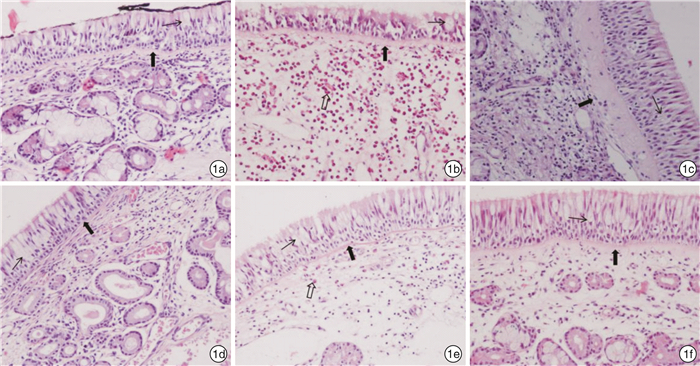
 下载:
下载:
